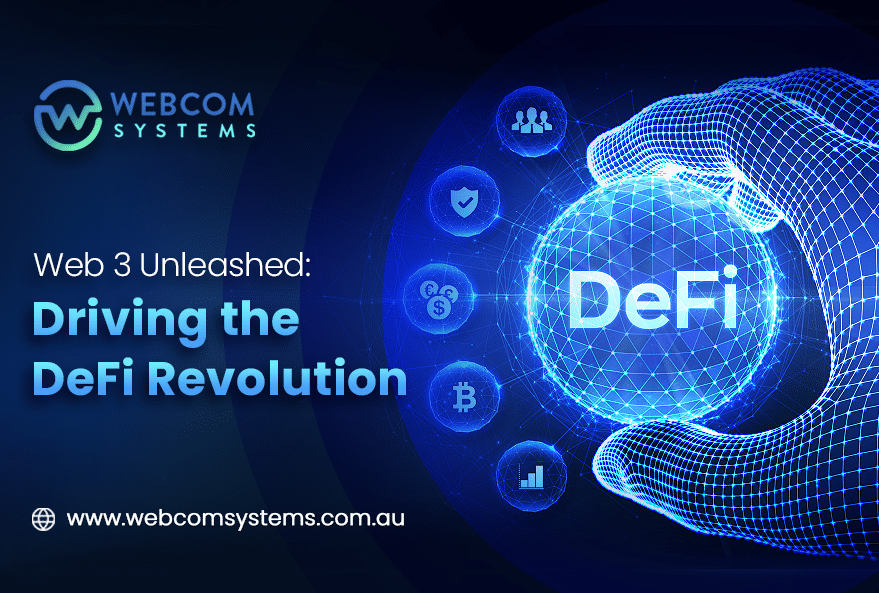Web 3 Unleashed: Driving the DeFi Revolution
Category : Blockchain / by Andrew
The digital world is moving away from the centralized control of Web 2.0 to the decentralized model of Web 3.0. This shift holds great potential for the digital landscape. This article explores the DeFi and Web 3.0 landscapes, offering a comprehensive understanding of their revolution and essential roles in shaping the future of global finance.
Understanding the DeFi and Web 3.0
Web 3.0 focuses on decentralization, allowing for direct exchanges between individuals through blockchain technology and cryptography. Unlike Web 2.0, it aims to restore user ownership and control over personal data while creating transparent, secure, and autonomous digital experiences.
Decentralized Finance (DeFi) in Web 3.0 has transformed traditional financial systems. DeFi offers a range of decentralized services and applications built on blockchain networks. This approach empowers individuals to conduct financial activities without relying on conventional intermediaries. These activities include lending, borrowing, trading, and earning interest.
Core Principles of Web 3
Web 3.0 comprises core principles that ensure trust, openness, and user empowerment through decentralized networks and secure, transparent technologies like blockchain. Following are the three significant principles of Web 3.0.
-
Peer-to-Peer Networks and Decentralization
The foundation of Web 3.0 consists of peer-to-peer (P2P) networks, facilitating direct connections between users without relying on intermediaries. It shifts power away from centralized organizations and gives individual members within the network more control and authority. This empowers each participant and creates a more diverse and democratic system.
-
Blockchain Technology’s Role
Web 3.0’s decentralization is created with blockchain technology. Through cryptographic methods and a decentralized ledger, blockchains facilitate the processing and validation of transactions among a network of computers. This provides a secure and efficient means of record-keeping. The inalterable quality of blockchain data guarantees transparency and confidence without the need for authority figures.
-
Transparency, Security, and Autonomy
Web 3.0 applications strongly emphasize transparency by providing open access to data and records of transactions, thereby promoting trust among all involved parties. The security is enforced by incorporating cryptographic protocols and consensus mechanisms into blockchain networks. Web 3.0 encourages user autonomy by giving individuals more authority over their digital identities, data, and interactions.
The Evolution of Decentralized Finance (DeFi)
The evolution of Decentralized Finance (DeFi) has transformed the finance sector. DeFi faced remarkable evolution and transcended to simple peer-to-peer trading by integrating decentralized exchanges (DEXs) like Uniswap and SushiSwap. It continues to evolve, offering a wide range of financial services in its complex and interconnected system. Some examples of yield farming protocols, such as Yearn, and lending and borrowing platforms, including Compound and Aave, showcase the innovative nature of decentralized finance.
The financial landscape transformed with the rise of innovative platforms like StakeDAO and Rocket Pool for staking and derivatives platforms like Synthetix. At the same time, key initiatives such as MakerDAO’s development of DAI, a decentralized stablecoin, and Chainlink’s support of decentralized oracle services have been instrumental in expanding the reach and potential of DeFi. This growth showcases the potential of DeFi in the global landscape.
Key Drivers Fueling the DeFi Revolution
The DeFi revolution is influenced and fueled by several key drivers, such as financial inclusivity and accessibility, yield farming, liquidity mining, incentives, interoperability and composability of DeFi protocols.
-
Financial Inclusivity and Accessibility
The DeFi revolution is driven by a strong desire to promote greater financial inclusivity and accessibility. DeFi platforms offer financial services to individuals worldwide, regardless of geographic location or socioeconomic status. Using blockchain technology, DeFi effectively eliminates any barriers to entry, opening up essential financial services such as lending, borrowing, and earning interest to populations that may have otherwise been unable to access them.
-
Yield Farming, Liquidity Mining, and Incentives
Innovative mechanisms such as yield farming and liquidity mining have influenced the rapid growth of DeFi. These incentivize users to participate with the reward of tokens or yields for adding liquidity to decentralized protocols. This approach attracts liquidity and encourages active engagement within DeFi ecosystems, driving the expansion of decentralized networks.
-
Interoperability and Composability of DeFi Protocols
The interoperability and composability are also driving factors of the DeFi revolution. By enabling smooth interaction and functionality sharing, interoperability empowers DeFi platforms to form a highly connected and efficient ecosystem. Using composability, developers can create innovative financial products by utilizing existing protocols and features.
Challenges and Opportunities in Web 3 and DeFi
Web 3.0 and DeFi face scalability issues, transaction throughput, regulatory concerns and compliance challenges. However, Web 3.0 and DeFi offer a range of opportunities as well. Following are the main challenges and opportunities of Web 3.0 and DeFi.
-
Scalability and Transaction Throughput
One of the significant obstacles that Web 3 and DeFi must face is scalability. As more users join, blockchain networks face transaction capacity and speed challenges, leading to congestion and increased fees. Ensuring scalability is crucial in achieving widespread acceptance and providing effortless user interactions in decentralized ecosystems.
-
Regulatory Concerns and Compliance Challenges
One major obstacle that remains in the way of DeFi’s widespread adoption is the uncertainty surrounding regulations. As governments around the globe struggle with defining and overseeing decentralized financial services, they must also address the difficulties of compliance. It creates complexities in balancing innovations while also maintaining regulatory compliance.
-
Opportunities for Innovation and Growth
Despite these challenges, the DeFi space offers many opportunities for innovation and growth. The scalability issue is currently being addressed through extensive research into layer-two solutions and alternative consensus mechanisms. The regulatory clarity can also open doors for institutional participation in DeFi. This would create a sense of trust and encourage an inflow of capital into the system. The potential for novel financial products, improved user experiences, and expanding use cases are also factors that influence the growth of the DeFi ecosystem.
Bottomline
The rise of Web 3 and the development of DeFi symbolize a significant change in financial systems that are decentralized, open, and more easily attainable. The true power of these technologies lies in their ability to make finance accessible to all and give people worldwide a sense of empowerment.
At Webcom Systems, we are a leading blockchain development company with years of experience. Our team of professionals excels in providing customized DeFi solutions using Web 3.0 technology, enhancing customer experience. Partner with us today to explore the world of Web 3.0 with the assistance of industry experts.
Also Read: What is Blockchain and Why is it the Next Big Thing?




